Ruby-Throated Hummingbird
Archilochus colubris
Ruby-throated hummingbirds can beat their wings more than 50 times per second.
Advertisement
Ruby-Throated Hummingbird Scientific Classification
- Kingdom
- Animalia
- Phylum
- Chordata
- Class
- Aves
- Order
- Apodiformes
- Family
- Trochilidae
- Genus
- Archilochus
- Scientific Name
- Archilochus colubris
Read our Complete Guide to Classification of Animals.
Ruby-Throated Hummingbird Conservation Status
Ruby-Throated Hummingbird Facts
- Prey
- Small insects, beetles, ants, aphids, gnats, mosquitoes, and wasps
- Fun Fact
- Ruby-throated hummingbirds can beat their wings more than 50 times per second.
- Estimated Population Size
- 7 million
- Biggest Threat
- Habitat loss
- Most Distinctive Feature
- Male’s ruby-red throat
- Other Name(s)
- Eastern hummingbird
- Wingspan
- 4 – 4.75 inches
- Incubation Period
- 11-16 days
- Litter Size
- 2
- Habitat
- Open woodlands
- Predators
- Hawks, owls, crows, kestrels, frogs, dragonflies, spiders
- Diet
- Omnivore
- Favorite Food
- Nectar
- Type
- Bird
- Common Name
- Hummingbird
- Number Of Species
- 1
- Location
- Eastern United States and Caribbean
- Nesting Location
- Tree or large shrub
- Age of Molting
- 12 months
- Migratory
- 1
View all of the Ruby-Throated Hummingbird images!
The ruby-throated hummingbird moves its wings over 50 times per second and can fly forward and backward, and even hover in place.
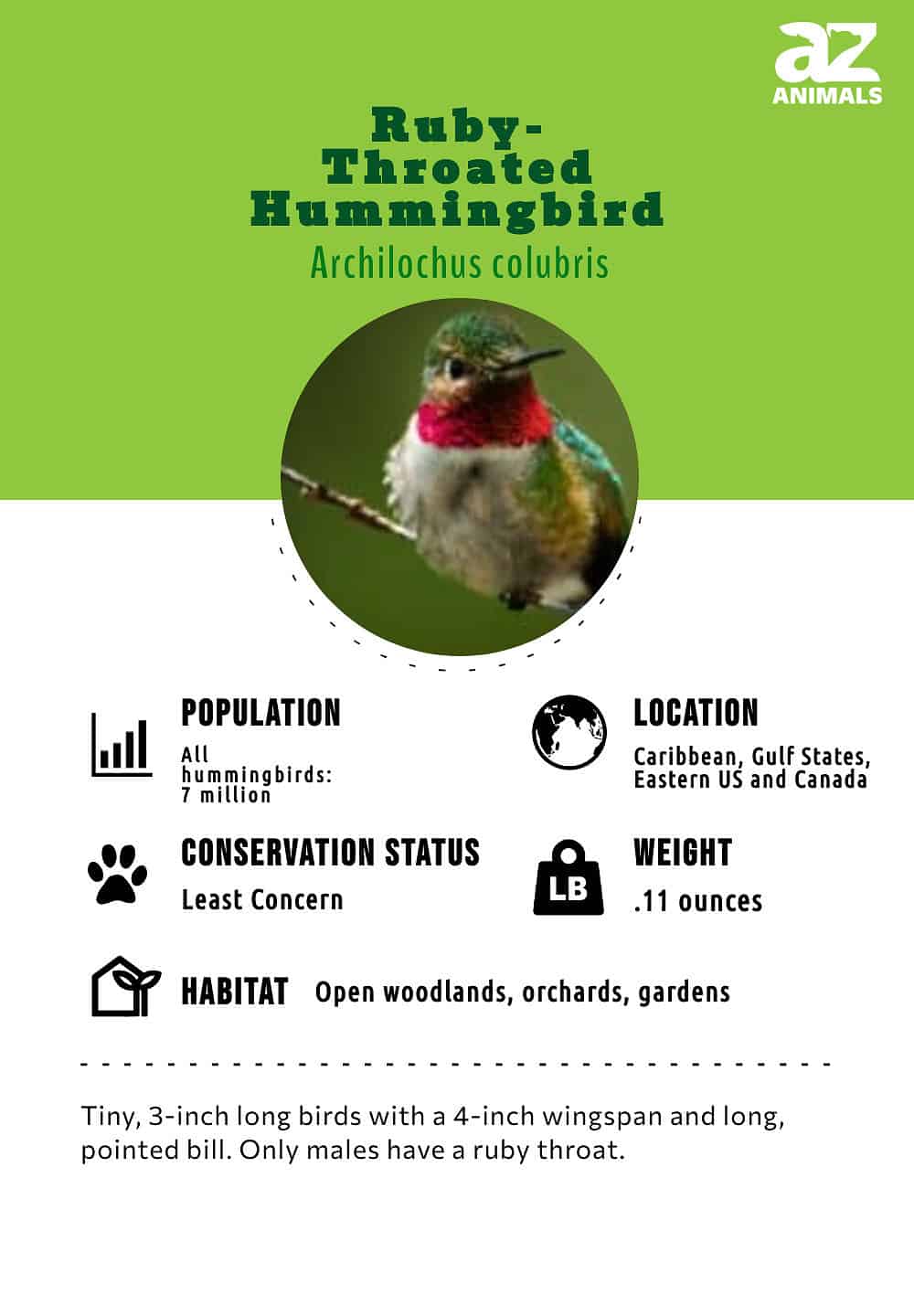
In many parts of the Eastern United States, the arrival of ruby-throated hummingbirds signifies that spring has finally arrived. These birds migrate about 2,100 miles twice a year. To attract them, fill your feeders and plant the right flowers as nectar, which is the preferred food of hummingbirds. While you may see them flocking near a food source, they have a solitary behavior.
4 Incredible Ruby-Throated Hummingbird Facts!
- Ruby-throated Hummingbirds can see into the ultraviolet light spectrum that humans cannot see.
- Ruby-throated hummingbirds prefer nectar from orange and red flowers.
- Ruby-throated hummingbirds are the only hummingbird to nest in the eastern United States. They usually lay between one-and-three eggs in each nest.
- The oldest ruby-throated hummingbird to be tagged was 9 years, 1 month old. The average lifespan is between 3 and 5 years.
Scientific Name and History
The scientific name of the ruby-throated hummingbird is Archilochus colubris. Famous Swedish botanist Carolus Linnaeus (1701-1778) named the bird.
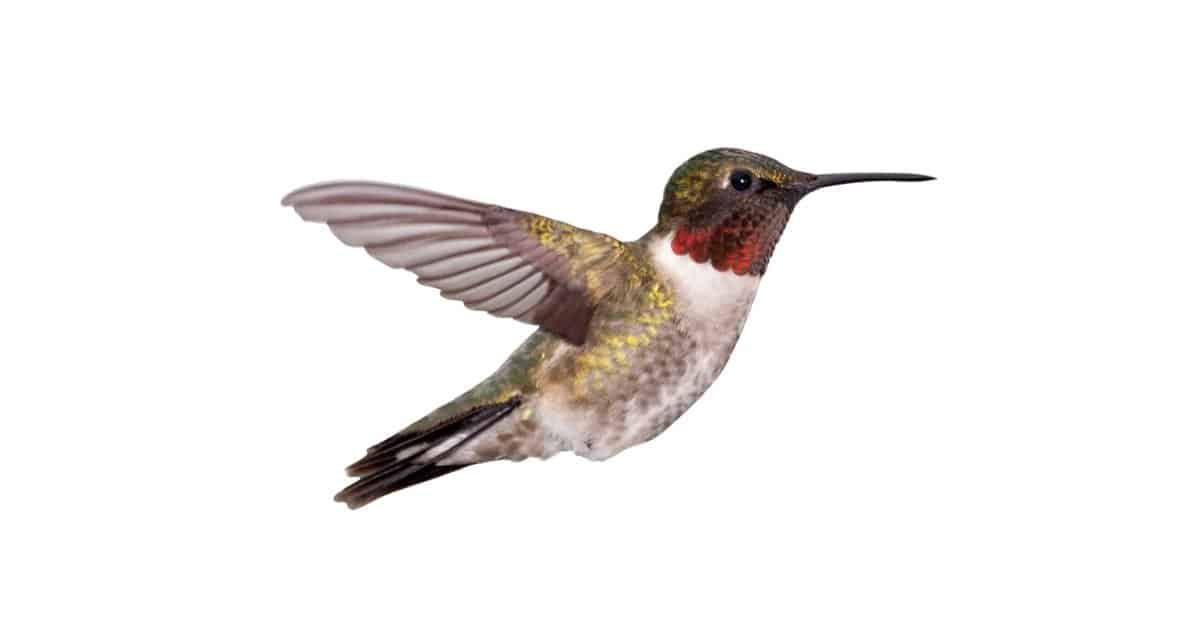
The Ruby-Throated Hummingbird shares a remarkable ancestry with other hummingbirds that thrived in the New World.
©Al Mueller/Shutterstock.com
Like all birds, this hummingbird is a member of the Aves class. Further, it is from the Apodiformes order, which includes swifts, and the Trochilidae family, which includes multiple hummingbird genera and species. For example: the Rufus hummingbird (Selasphorus rufus), Anna’s hummingbird (Calypte anna), and Costa’s hummingbird (Calypte costae).
The word Apodiformes means “no feet.” People may have once thought that hummingbirds did not need feet because they are usually seen only in flight. Still, they need feet for perching, even if their legs are too short for walking or hopping, and they can sometimes shuffle sideways to move on a branch.
The family name Trochilidae means small bird. It is used to apply to hummingbirds only. Finally, they are members of the Archilochus genus, a Greek word that can mean first in importance or a chief.
The species name colubris is Latin for serpent, which doesn’t fit, so it is believed that Linnaeus misspelled the name and meant the Spanish colibrí or French colibre, meaning “hummingbird.”
The bird that became the hummingbird shares an ancestor that lived about 65 million years ago with the species in the order Caprimulgiformes. Then, 45-55 million years ago, an early version of the hummingbird, much like a swift, diverged from that group and has been making its own path of adaptations since. Fossil evidence shows it in Europe and Asia at least 47 million years ago. Fossils from 30 million years ago indicate that it had developed its hovering ability and other modifications unique to the hummingbird.
Although it originated in the Old World, the hummingbird made its way into the Americas and thrived, spawning about 340 species. While it died out in Europe and Asia, it became the stuff of legends among the Mayans and the natives of North America.
Appearance and Behavior
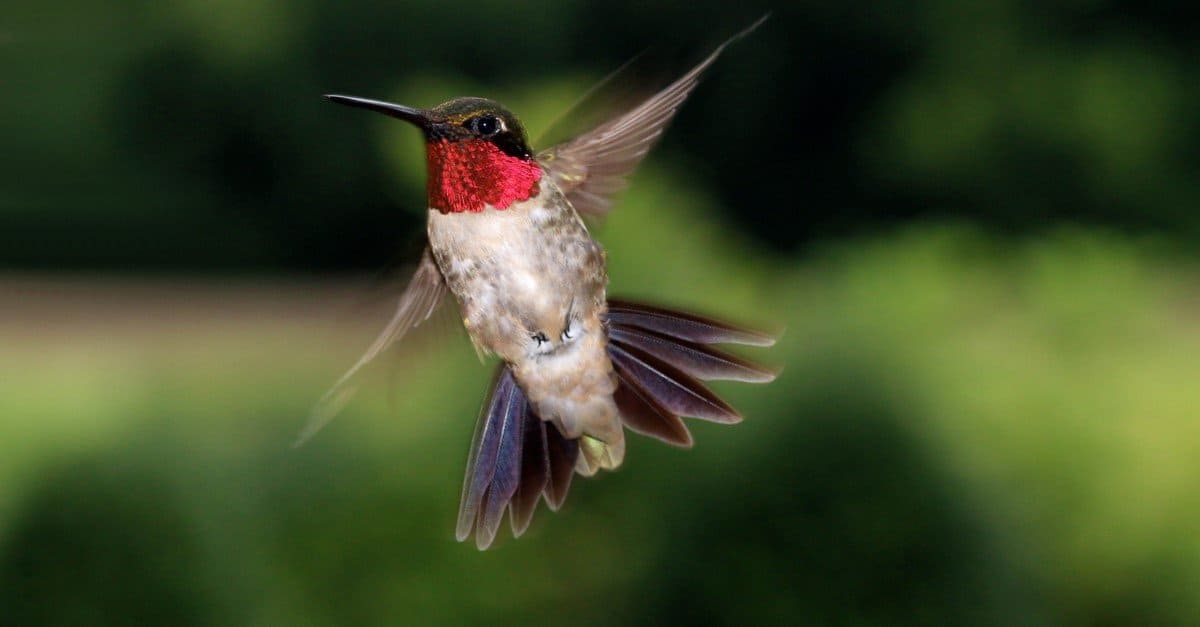
Male Ruby-Throated Hummingbird in flight showing its grey breast and pointed tail feathers.
©Ramona Edwards/Shutterstock.com
Ruby-throated hummingbirds are the smallest of all birds. They weigh 0.11 ounces and are about 3 inches long with a 4-inch wingspan. Males are about 20% smaller than females and have bills that are a bit shorter. Juvenile birds often look like females even when they are males. The bill is approximately 20% of the bird’s length.
Male vs. Female
Older adult males look much darker than females and young males. There are four other differences between male and female ruby-throated hummingbirds as well:
| Male | Female |
| Ruby-red throat | White throat |
| Pointed tail feathers | Rounded tail feather; outer three tail feathers have a white tip. |
| Forked tail | Fan-shaped tail |
| Gray breast | White breast |
The name ruby-throated therefore refers to the male of the species. The eye of this hummingbird appears black. A patch of tiny white feathers is right behind the eye.
This bird’s 4-inch wingspan means that the wings may appear longer than the tail when the bird is resting. Males always have points at the end of their feathers, even when they are young. While the plumage on this hummingbird’s back can appear lighter or darker, it will be emerald green.
These birds have three toes on their feet in the front and one toe in the back. Especially when females are pregnant, their legs may swell, making them look bigger than those on male birds.
Migration Pattern and Timing
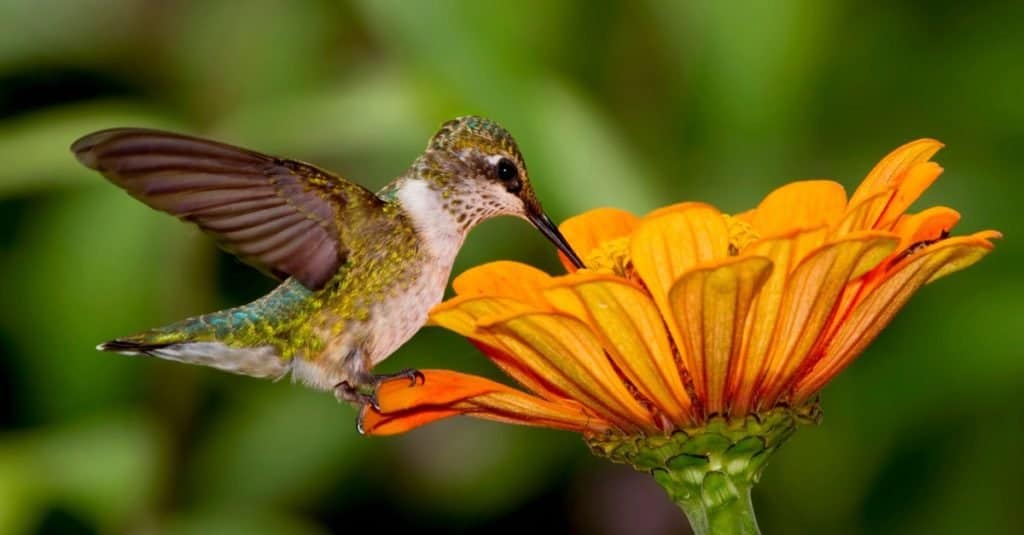
Female Ruby-Throated Hummingbird sipping nectar from an orange flower, which it prefers, in one of the bird’s many locations during the year.
©John L. Absher/Shutterstock.com
The spring migration usually starts in late February or early March. Males precede females by 10 to 14 days in leaving the Caribbean. By mid-March, the ruby-throated hummingbirds have reached the Gulf States. Then, they move up through the eastern United States until they reach Canada in early May, where they will spend the summer months.
These birds migrate back to the Caribbean in the winter. Many leave Canada by the end of July. While some believe that ruby-throated hummingbirds cross the Yucatan Peninsula during fall migration, just like they do during the spring one, others doubt that theory. They suggest that some birds, especially weaker ones, leave Southern Florida and use Cuba as a resting spot before traveling to their final Caribbean destination.
It may be up to each hummingbird to use its instincts to determine the best migration route because each ruby-throated hummingbird makes the trip by itself, which is quite a feat, especially considering it is the longest migration of any bird.
Location
Where you can find ruby-throated hummingbirds depends on the time of year. These birds start their year in the Caribbean. They can fly over 500 miles without stopping to rest. In order to prepare for the migration, they put on about an extra 30% of their body weight. They live in Canada and the United States during the summer months. You can see them along the Gulf Coast and in Mexico while they are moving from one location to the other.
If you listen carefully, you may hear the hum of the hummingbirds’ wings before you hear their calls. Males make a lot of calls at daybreak. When they are chasing each other, they use particular calls.
Nest
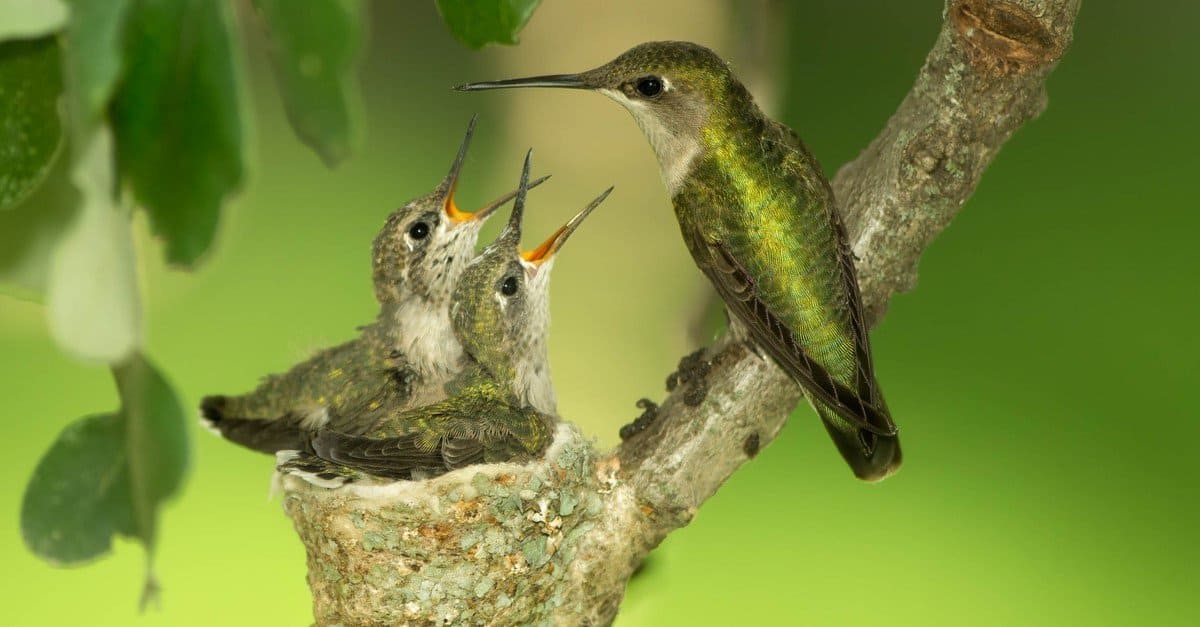
Female Ruby-Throated Hummingbird feeding her chicks in the nest.
©Agnieszka Bacal/Shutterstock.com
Ruby-throated hummingbirds build their nests in trees or large shrubs from 5-to-40-feet off the ground. They prefer a downward sloping limb on a deciduous tree. They have also been known to build their nests on roofs, poles, and other available places. Unlike some birds who try to make their nests away from humans, ruby-throated hummingbirds do not care if their nest is next to human habitations.
The nests are constructed out of spider silk and plant material. The silk allows the nest to expand naturally after the babies are born to accommodate their growing size and increased activities. The female spends up to 10 days building the nest alone. She puts the finishing touches on it by camouflaging it in lichen or other plant material. She then lays between one and three eggs in the nest where they will hatch in two weeks. Ruby-throated hummingbirds then leave the nest in about three weeks.
Diet
The preferred diet of ruby-throated hummingbirds is nectar. They have a preference for orange and red plants but will eat nectar from almost any plant. Additionally, they will eat spiders, tiny insects like ants, aphids, gnats, mosquitoes and wasps, and even beetles. Their consumption of insects goes up in the winter months when nectar is harder to find. It may also help the birds have the nutrients they need to make their long migration.
Predators, Threats, and Conservation Status
Dragonflies, praying mantises, and orb-weaver spiders are predators who lay in wait for a ruby-throated hummingbird to come too close. Additionally, they are eaten by other birds, like the roadrunner and loggerhead shrike, which find them a tasty meal, as well as birds of prey like owls, hawks, and kestrels. Finally, some frogs mistake them for insects.
Loss of habitat is a problem for ruby-throated hummingbirds. Yet, their population remains stable and is possibly increasing. The IUCN lists the ruby-throated hummingbird as least concern. There are approximately 7 million of these hummingbirds.
View all 114 animals that start with RRuby-Throated Hummingbird FAQs (Frequently Asked Questions)
What's the Difference Between a Ruby-Throated Hummingbird Male vs Female?
A female ruby-throated hummingbird is smaller than the male. It has a rounded tail. Only the male has the red throat that gives this species its common name. The female has a rounder tail than the male.
What Does a Female Ruby-Throated Hummingbird Look Like?
Female ruby-throated hummingbirds have a round tail, a bright green back, and a grayish-white breast. The legs on the female often appear fatter than on the male, but scientists think that may be from swelling, especially when pregnant.
Are Ruby-Throated Hummingbirds Rare?
No, ruby-throated hummingbirds are not rare. There are more than 7 million of them in the world.
Are Ruby-Throated Hummingbirds Male or Female?
Yes, there are male and female ruby-throated hummingbirds.
How Do You Tell a Male Hummingbird From a Female?
Telling a male from a female can be difficult because hummingbirds can move up to 40 miles an hour. The first thing to think about is if the bird appears a darker color or a lighter one. If the bird is darker, then see if he has a forked tail. Male hummingbirds have a forked tail while female ones have a fan-shaped one. Take a look at the breast and see if it is brownish-grey. If it is, then you are looking at a male. Likewise, males have a red throat while females have a white one usually. Finally, see if you can spot white on the tail. If there is white, then the facts are that you are looking at a female.
How much does a Ruby-Throated Hummingbird Weigh?
A ruby-throated hummingbird weighs 0.11 ounces. Therefore, the facts are that this weight is a little less weight than a nickel and a little more than a dime.
How Long Does a Ruby-Throated Hummingbird Live?
The lifespan of most ruby-throated hummingbirds is between 3-and-5 years. The oldest banded ruby-throated hummingbird lived to be 9 years 1 month old.
Thank you for reading! Have some feedback for us? Contact the AZ Animals editorial team.
Sources
- Audubon, Available here: https://www.audubon.org/news/which-animals-prey-hummingbirds
- Datazone, Available here: http://datazone.birdlife.org/species/factsheet/22688193
- Hummingbird-guide, Available here: https://www.hummingbird-guide.com/hummingbird-migration.html
- Field Guide to Hummingbirds, Available here: https://fieldguidetohummingbirds.com/fall-migration-ruby-throated/
- All About Birds, Available here: https://www.allaboutbirds.org/guide/Ruby-throated_Hummingbird/overview
- Operation Rubythroat, Available here: http://www.rubythroat.org/RTHUTaxonomyMain.html
- US Forest Service, Available here: https://www.fs.fed.us/wildflowers/pollinators/pollinator-of-the-month/ruby-throated_hummingbird.shtml#:~:text=Although%20Ruby%2Dthroated%20Hummingbirds%20are,crossing%20the%20Gulf%20of%20Mexico.
- The Spruce, Available here: https://www.thespruce.com/hummingbird-predators-386304

















